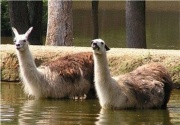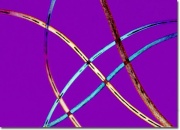Difference between revisions of "Llama"
(username removed) |
|||
| (4 intermediate revisions by 4 users not shown) | |||
| Line 1: | Line 1: | ||
| − | [[File:Llamaswp2.jpg|thumb|Llama | + | [[File:Llamaswp2.jpg|thumb|Llama ''Lama glama'']] |
| − | |||
| − | ''Lama glama'']] | ||
== Description == | == Description == | ||
A member of the camel family (''Lama glama'') native to the high altitude regions of western South America. Llamas have been domesticated and are raised for their fleece and milk as well as being used for transportation and carrying packs. Llama fleece contains thick coarse outer hairs along with downy, soft inner hairs. The fine hairs can be 12 inches (30 cm) in length. The fleece is sheared yearly. The guard hairs are used for ropes and rugs while the softer underfur is used for sweaters, blankets, hats, and clothing. Llama hair is not as highly valued as alpaca or vicuna hair. | A member of the camel family (''Lama glama'') native to the high altitude regions of western South America. Llamas have been domesticated and are raised for their fleece and milk as well as being used for transportation and carrying packs. Llama fleece contains thick coarse outer hairs along with downy, soft inner hairs. The fine hairs can be 12 inches (30 cm) in length. The fleece is sheared yearly. The guard hairs are used for ropes and rugs while the softer underfur is used for sweaters, blankets, hats, and clothing. Llama hair is not as highly valued as alpaca or vicuna hair. | ||
| − | Other similar species are: [ | + | Other similar species are: [[alpaca]], [[vicuna]], and [[guanaco]]. The juarizo is a crossbreed with a llama father and an alpaca mother. The opposite combination (llama mother and alpaca father) is called a paco. |
[[File:llama1large.jpg|thumb|Llama]] | [[File:llama1large.jpg|thumb|Llama]] | ||
| + | |||
== Synonyms and Related Terms == | == Synonyms and Related Terms == | ||
Lama glama;; juarizo; paco; Lama (Deut., Fr., It., Ned., Pol., Sven.); llama (Esp.); lhama (Port.); | Lama glama;; juarizo; paco; Lama (Deut., Fr., It., Ned., Pol., Sven.); llama (Esp.); lhama (Port.); | ||
| − | == | + | == Physical and Chemical Properties == |
| − | Fiber length = 30 cm (undercoat). Medulla is narrow and often pigmented. Cross section is circular to ovoid | + | * Fiber length = 30 cm (undercoat). |
| + | * Medulla is narrow and often pigmented. | ||
| + | * Cross section is circular to ovoid | ||
== Comparisons == | == Comparisons == | ||
| Line 21: | Line 22: | ||
[[media:download_file_165.pdf|Properties of Natural Fibers]] | [[media:download_file_165.pdf|Properties of Natural Fibers]] | ||
| + | ==Resources and Citations== | ||
| + | * Rosalie Rosso King, ''Textile Identification, Conservation, and Preservation'', Noyes Publications, Park Ridge, NJ, 1985 | ||
| − | + | * Marjory L. Joseph, ''Introductory Textile Science'', Holt, Rinehart and Winston, Fort Worth, TX, 1986 | |
| − | |||
| − | |||
| − | |||
| − | |||
| − | |||
| − | |||
| − | |||
| − | |||
| − | * | ||
| − | |||
| − | |||
| − | * | + | * J.Gordon Cook, ''Handbook of Textile Fibres:I Natural Fibres'', Merrow Publishing Co. , Durham, England, 1984 |
* ''Identification of Textile Materials'', The Textile Institute, Manchester, England, 1985 | * ''Identification of Textile Materials'', The Textile Institute, Manchester, England, 1985 | ||
| − | * ''Encyclopedia Britannica'', http://www.britannica.com Comment: "llama." | + | * ''Encyclopedia Britannica'', http://www.britannica.com Comment: "llama." Accessed 13 Dec. 2004. |
| − | * | + | * Edward Reich, Carlton J. Siegler, ''Consumer Goods: How to Know and Use Them'', American Book Company, New York City, 1937 |
| − | * | + | * Random House, ''Webster's Encyclopedic Unabridged Dictionary of the English Language'', Grammercy Book, New York, 1997 |
* ''The American Heritage Dictionary'' or ''Encarta'', via Microsoft Bookshelf 98, Microsoft Corp., 1998 | * ''The American Heritage Dictionary'' or ''Encarta'', via Microsoft Bookshelf 98, Microsoft Corp., 1998 | ||
Latest revision as of 16:01, 15 October 2022
Description
A member of the camel family (Lama glama) native to the high altitude regions of western South America. Llamas have been domesticated and are raised for their fleece and milk as well as being used for transportation and carrying packs. Llama fleece contains thick coarse outer hairs along with downy, soft inner hairs. The fine hairs can be 12 inches (30 cm) in length. The fleece is sheared yearly. The guard hairs are used for ropes and rugs while the softer underfur is used for sweaters, blankets, hats, and clothing. Llama hair is not as highly valued as alpaca or vicuna hair.
Other similar species are: Alpaca, Vicuna, and Guanaco. The juarizo is a crossbreed with a llama father and an alpaca mother. The opposite combination (llama mother and alpaca father) is called a paco.
Synonyms and Related Terms
Lama glama;; juarizo; paco; Lama (Deut., Fr., It., Ned., Pol., Sven.); llama (Esp.); lhama (Port.);
Physical and Chemical Properties
- Fiber length = 30 cm (undercoat).
- Medulla is narrow and often pigmented.
- Cross section is circular to ovoid
Comparisons
Resources and Citations
- Rosalie Rosso King, Textile Identification, Conservation, and Preservation, Noyes Publications, Park Ridge, NJ, 1985
- Marjory L. Joseph, Introductory Textile Science, Holt, Rinehart and Winston, Fort Worth, TX, 1986
- J.Gordon Cook, Handbook of Textile Fibres:I Natural Fibres, Merrow Publishing Co. , Durham, England, 1984
- Identification of Textile Materials, The Textile Institute, Manchester, England, 1985
- Encyclopedia Britannica, http://www.britannica.com Comment: "llama." Accessed 13 Dec. 2004.
- Edward Reich, Carlton J. Siegler, Consumer Goods: How to Know and Use Them, American Book Company, New York City, 1937
- Random House, Webster's Encyclopedic Unabridged Dictionary of the English Language, Grammercy Book, New York, 1997
- The American Heritage Dictionary or Encarta, via Microsoft Bookshelf 98, Microsoft Corp., 1998

